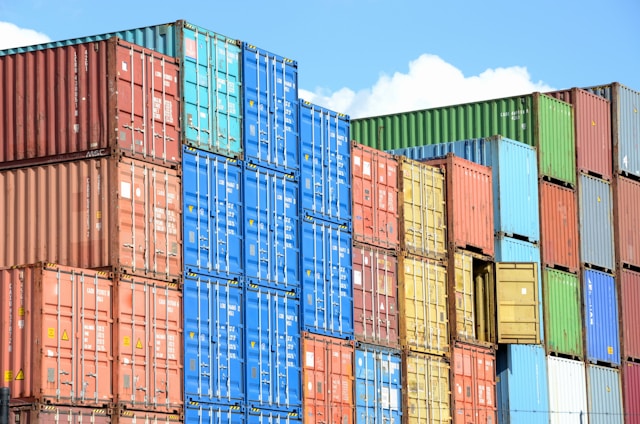Introduction: Transforming Logistics with Shipping Containers
The advent of shipping containers revolutionized the supply chain, offering a new way to transport, store, and deliver goods globally. We are committed to further harnessing these innovations to boost the efficiency of supply chains, ensuring faster, more secure, and environmentally friendly movement of products worldwide.

Photo by Paul Teysen on Unsplash
Enhancing Logistics Through Standardization and Security
Embrace Standardization for Increased Efficiency
Shipping containers have standardized dimensions and capacities, which simplifies global trade logistics. Embrace these standards to ensure consistent and efficient loading, transportation, and unloading processes, significantly cutting costs and reducing transit times. This consistency facilitates smoother transitions from production to market, optimizing operations and reducing delays across borders.
Secure Your Cargo with Robust Container Designs
Opt for robust, tamper-resistant shipping containers to enhance the security of transported goods. These containers are designed to withstand damage and protect the contents from theft and environmental elements, providing peace of mind for both shippers and receivers.
Deploy Advanced Technologies for Enhanced Container Management
Implement IoT and Real-Time Tracking
Incorporate Internet of Things (IoT) and real-time tracking technologies into your shipping containers. This step allows for detailed monitoring of container conditions, precise tracking of their locations, and effective management of the entire supply chain. This implementation ensures on-time delivery and reduces the risks associated with misrouting or delays.
Automate with Robotics for Efficiency
Utilize automation technologies, such as automated stacking cranes and autonomous vehicles, in ports and warehouses. These innovations minimize human error, enhance operational speed and efficiency, and decrease labor costs, thereby bolstering the resilience and adaptability of your supply chain to market demands.
Expanding Intermodal Capabilities for Greater Efficiency
To further enhance supply chain efficiency, consider expanding the capabilities of intermodal transport systems. By optimizing routes and connections between rail, road, and sea transport, shipping containers can be moved more swiftly and economically. This integration facilitates quicker turnover rates and reduces logistics congestion, especially in major port areas.
Explore Modular and Flexible Container Options
Adapt Containers to Meet Various Cargo Requirements
Future shipping container designs are likely to be modular and adaptable, suited for different types of cargo, including perishables and oversized items. Adopting such flexible container solutions not only improves handling efficiency but also maximizes container utilization. This approach reduces the costs associated with transporting empty containers and enhances the overall sustainability of the supply chain.
Enhance Resilience with Diversified Container Usage
To further bolster the resilience of your supply chain, consider diversifying the types of shipping containers you employ. This approach not only accommodates a wider range of goods but also prepares your logistics network to handle unexpected demands or changes in the market.
When it comes to new shipping containers, they offer unparalleled adaptability, security, and compliance with international standards. These containers are designed to withstand harsh environmental conditions while providing optimal storage and transportation solutions. Investing in new shipping containers ensures your supply chain remains agile, environmentally sustainable, and responsive to global market demands.
Utilize Specialized Containers for Niche Markets
Deploy specialized containers, such as ventilated units for agricultural products or insulated versions for temperature-sensitive pharmaceuticals. These tailored solutions meet specific logistical requirements, ensuring that even the most delicate or unique items can be transported under optimal conditions, thus reducing spoilage or damage.
Leverage High Cube Containers for Increased Capacity
Integrate high cube containers into your fleet to take advantage of their increased height, ideal for lightweight but voluminous goods. This adaptation allows for more efficient packing and can lead to significant cost savings in freight charges, particularly for industries such as automotive components or furniture where volume often outweighs weight.
Streamline Operations with Container Pooling
Adopt a container pooling system to reduce the number of empty runs and enhance the overall efficiency of container usage. By sharing container resources among multiple stakeholders, your operation can decrease downtime and increase the availability of containers where they are most needed, reducing logistical bottlenecks and enhancing supply chain fluidity.
Leverage Containers to Foster Economic and Environmental Growth
Foster Economic Connectivity
Shipping containers have reduced logistical barriers, enhancing economic ties between regions and facilitating smoother, faster trade. By lowering these barriers, containers have helped businesses expand their reach and boosted economic globalization.
Promote Sustainability in Your Supply Chain
Commit to using shipping containers to decrease the environmental impact of your logistics activities. By optimizing transportation routes and integrating with different modes of transport, these containers help reduce the number of trips required, which significantly lowers emissions and supports environmental stewardship.
Conclusion: Advancing the Future of Shipping Containers
Shipping containers, from their inception to their current pivotal role in global trade, continue to evolve and drive supply chain innovations. Looking forward, advancements in container technology and design are expected to further enhance operational efficiency, security, and environmental sustainability. By adopting these innovative practices, shipping containers will remain integral to optimizing supply chain operations and reshaping global trade dynamics.




